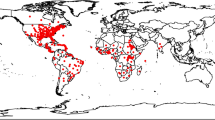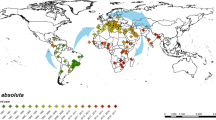Abstract
Predicting the potential geographical distribution of a species is particularly important for pests with strong invasive abilities. Tetranychus evansi Baker & Pritchard, possibly native to South America, is a spider mite pest of solanaceous crops. This mite is considered an invasive species in Africa and Europe. A CLIMEX model was developed to predict its global distribution. The model results fitted the known records of T. evansi except for some records in dry locations. Dryness as well as excess moisture stresses play important roles in limiting the spread of the mite in the tropics. In North America and Eurasia its potential distribution appears to be essentially limited by cold stress. Detailed potential distribution maps are provided for T. evansi in the Mediterranean Basin and in Japan. These two regions correspond to climatic borders for the species. Mite establishment in these areas can be explained by their relatively mild winters. The Mediterranean region is also the main area where tomato is grown in open fields in Europe and where the pest represents a threat. According to the model, the whole Mediterranean region has the potential to be extensively colonized by the mite. Wide expansion of the mite to new areas in Africa is also predicted. Agricultural issues highlighted by the modelled distribution of the pest are discussed.





Similar content being viewed by others
References
Andrewartha HG, Birch LC (1954) The distribution and abundance of animals. The University of Chicago Press, Chicago
Anonymous (2007) Solanaceae Source. http://www.nhm.ac.uk/research-curation/ressearch/projects/solanaceaesource/. Accessed 15 Sep 2008
Baker RHA, Sansford CE, Jarvis CH, Cannon RJC, MacLeod A, Walters KFA (2000) The role of climatic mapping in predicting the potential geographical distribution of non-indigenous pests under current and future climates. Agric Ecosyst Environ 82:57–71. doi:10.1016/S0167-8809(00)00216-4
Beaumont LJ, Hughes L, Poulsen M (2005) Predicting species distributions: use of climatic parameters in BIOCLIM and its impact on predictions of species’ current and future distributions. Ecol Model 186:251–270. doi:10.1016/j.ecolmodel.2005.01.030
Blair BW (1983) Tetranychus evansi Baker & Pritchard (Acari : Tetranychidae); a new pest of tobacco in Zimbabwe. In: Coresta Phytopathology and Agronomy Study Groups, Bergerac, France, pp 1–6
Bolland HR, Gutierrez J, Flechtmann CHW (1998) World catalogue of the spider mite family (Acari: Tetranychidae). Brill Academic Publishers, Leiden
Bonato O (1999) The effect of temperature on life history parameters of Tetranychus evansi (Acari: Tetranychidae). Exp Appl Acarol 23:11–19. doi:10.1023/A:1006144610009
Boubou A, Cros-Arteil S, Navajas M (2006) Genetic markers to trace the dissemnination of Tetranychus evansi, a new invasive spider mite in Europe. In: Abstracts of the XIIth International Congress of Acarology, Amsterdam
Brown JH, Stevens GC, Kaufman DM (1996) The geographic range: size, shape, boundaries and internal structure. Annu Rev Ecol Syst 27:597–623. doi:10.1146/annurev.ecolsys.27.1.597
Costa JM, Heuvelink E (2005) Introduction: the tomato crop and industry. In: Heuvelink E (ed) Tomatoes. CABI Publishing, Wallingford, UK, pp 1–19
Davis AJ, Jenkinson LS, Lawton JH, Shorrocks B, Wood S (1998) Making mistakes when predicting shifts in species range in response to global warming. Nature 391:783–786. doi:10.1038/35842
De Moraes GJ, McMurtry JA (1987) Effect of temperature and sperm supply on the reproductive potential of Tetranychus evansi (Acari: Tetranychidae). Exp Appl Acarol 3:95–107. doi:10.1007/BF01270471
De Moraes GJ, McMurtry JA, Baker EW (1987) Redescription and distribution of the spider mites Tetranychus evansi and T. marianae. Acarologia 28:333–343
Duverney C, Ngueye-Ndiaye A (2005) Essais préliminaires pour limiter les dégâts de Tetranychidae sur les cultures maraîchères dans le Sine-Saloum (Sénégal). In: Deuxième colloque international sur les acariens des cultures. AFPP Paris, Montpellier
Ehara S, Ohashi K (2002) A new species of Tetranychus (Acari: Tetranychidae) from the Kinki District, Japan. Acta Arachnol 51:19–22. doi:10.2476/asjaa.51.19
Ferragut F, Escudero LA (1999) Tetranychus evansi Baker & Pritchard (Acari, Tetranychidae), una nueva araña roja en los cultivos horticolas españoles. Bol Sanid Veg Plagas 25:157–164
Ferragut F, Escudero LA (2002) La araña roja del tomate Tetranychus evansi (Acari, Tetranychidae) en España: distribuciòn, biologìa y control. Phytoma Espana 132:111–113
Fiaboe KKM, Fonseca RL, De Moraes GJ, Ogol CKPO, Knapp M (2006) Identification of priority areas in South America for exploration of natural enemies for classical biological control of Tetranychus evansi (Acari: Tetranychidae) in Africa. Biol Control 38:373–379. doi:10.1016/j.biocontrol.2006.05.011
Fiaboe KKM, Gondim MGC Jr, De Moraes GJ, Ogol CKPO, Knapp M (2007) Surveys for natural enemies of the tomato red spider mite Tetranychus evansi (Acari: Tetranychidae) in northeastern and southeastern Brazil. Zootaxa 1395:33–58
Furtado IP (2006) Sélection d’ennemis naturels pour la lutte biologique contre Tetranychus evansi Baker & Pritchard (Acari: Tetranychidae), en Afrique. PhD University Montpellier II
Furtado IP, De Moraes GJ, Kreiter S, Knapp M (2006) Search for effective natural enemies of Tetranychus evansi in south and southeast Brazil. Exp Appl Acarol 40:157–174. doi:10.1007/s10493-006-9045-y
Furtado IP, Toledo S, De Moraes GJ, Kreiter S, Knapp M (2007) Search for effective natural enemies of Tetranychus evansi (Acari: Tetranychidae) in northwest Argentina. Exp Appl Acarol 43:121–127. doi:10.1007/s10493-007-9104-z
Gotoh T, Araki R, Boubou A, Migeon A, Navajas M (2009) Evidence of co-specificity between Tetranychus evansi and T. takafujii (Acari, Prostigmata, Tetranychidae) suggested by molecular, morphological and compatibility data: comments on taxonomical and agricultural consequences. Zoologica Scripta (submitted)
Guisan A, Thuiller W (2005) Predicting species distribution: offering more than simple habitat models. Ecol Lett 8:993–1009. doi:10.1111/j.1461-0248.2005.00792.x
Gutierrez J, Etienne J (1986) Les Tetranychidae de l’île de la Réunion et quelques-uns de leurs prédateurs. Agronomie Trop 41:84–91
Hijmans RJ, Guarino L, Cruz M, Rojas E (2001) Computer tools for spatial analysis of plant genetic resources data: 1. DIVA-GIS. Plant Genet Resour Newsl 127:15–19
Hijmans RJ, Cameron SE, Parra JL, Jones PG, Jarvis A (2005) Very high resolution interpolated climate surfaces for global land areas. Int J Climatol 25:1965–1978. doi:10.1002/joc.1276
Hodkinson ID (1999) Species response to global environmental change or why ecophysiological models are important: a reply to Davis et al.. J Anim Ecol 68:1259–1262. doi:10.1046/j.1365-2656.1999.00372.x
Hussey NW, Parr WJ (1963) Dispersal of the glasshouse red spider mite Tetranychus urticae Koch (Acarina, Tetranychidae). Entomol Exp Appl 6:207–214. doi:10.1007/BF00300527
Hutchinson GE (1957) Concluding remarks. Cold Spring Harb Symp Quant Biol 22:415–427
Jeppson LR, Keifer HH, Baker EW (1975) Mites injurious to economic plants. University of California Press, Berkeley
Kenis M, Rabitsch W, Auger-Rozenberg MA, Roques A (2007) How can alien species inventories and interception data help us prevent insect invasions? Bull Entomol Res 97:489–502. doi:10.1017/S0007485307005184
Kennedy GC, Smitley DR (1985) Dispersal. In: Helle W, Sabelis MW (eds) Spider mites, their biology, natural enemies and control. Elsevier, Amsterdam, pp 233–242
Kiritani K (2006) Predicting impacts of global warming on population dynamics and distribution of arthropods in Japan. Popul Ecol 48:5–12
Kotsubo Y, Ohashi K, Takafuji A (2004) Ecological performance of Tetranychus takafujii (Acari: Tetranychidae), a species from Kinki district, Japan. J Acarol Soc Jpn 13:71–76. doi:10.2300/acari.13.71 in Japanese with English abstract
Kriticos DJ, Randall RP (2001) A comparison of systems to analyse potential weed distributions. In: Groves RH, Panetta FD, Virtue JG (eds) Weed risk assessment. CSIRO Publishing, Melbourne, pp 61–79
Kriticos DJ, Yonow T, McFadyen RE (2005) The potential distribution of Chromolaena odorata (Siam weed) in relation to climate. Weed Res 45:246–254. doi:10.1111/j.1365-3180.2005.00458.x
Mack RN, Simberloff D, Lonsdale WM, Evans H, Clout M, Bazzaz FA (2000) Biotic invasions: causes, epidemiology, global consequences, and control. Ecol Appl 10:689–710. doi:10.1890/1051-0761(2000)010[0689:BICEGC]2.0.CO;2
McNeely JA (2006) As the world gets smaller, the chances of invasion grow. Euphytica 148:5–15. doi:10.1007/s10681-006-5937-5
Migeon A (2005) Un nouvel acarien ravageur en France: Tetranychus evansi Baker et Pritchard. Phytoma—La Défense des Végétaux 579:38–43
Migeon A (2007) Acarien rouge de la tomate: nouvelles observations et perspectives. PHM Rev Horticole 488:20–24
Migeon A, Dorkeld F (2007) Spider Mites Web: a comprehensive database for the Tetranychidae. http://www.montpellier.inra.fr/CBGP/spmweb/. Accessed 15 Sep 2008
Navia D, Mendonca RS, De Melo LAMP (2005) Steneotarsonemus spinki—an invasive tarsonemid mite threatening rice crops in South America. In: Plant protection and plant health in Europe: introduction and spread of invasive species, held at Humboldt University, Berlin, Germany, 9–11 June 2005. British Crop Protection Council, Alton UK, pp 267–268
New M, Hulme M, Jones PD (1999) Representing twentieth century space-time climate variability. Part 1: development of a 1961–90 mean monthly terrestrial climatology. J Clim 12:829–856. doi:10.1175/1520-0442(1999)012<;0829:RTCSTC>;2.0.CO;2
New M, Lister D, Hulme M, Makin I (2002) A high-resolution data set of surface climate over globbal land areas. Clim Res 21:1–25. doi:10.3354/cr021001
Ohashi K, Kotsubo Y, Takafuji A (2003) Distribution and overwintering ecology of Tetranychus takafujii (Acari: Tetranychidae), a species found from Kinki district, Japan. J Acarol Soc Jpn 12:107–113. doi:10.2300/acari.12.107 in Japanese with English abstract
Olson DM, Dinerstein E, Wikramanayake ED et al (2001) Terrestrial ecoregions of the world: a new map of life on earth. Biosciences 51:933–938. doi:10.1641/0006-3568(2001)051[0933:TEOTWA]2.0.CO;2
Rosa AA, Gondim MGC Jr, Fiaboe KKM, De Moraes GJ, Knapp M (2005) Predatory mites associated with Tetranychus evansi Baker & Pritchard (Acari: Tetranychidae) on native solanaceous plants of coastal Pernambuco State, Brazil. Neotrop Entomol 34:689–692. doi:10.1590/S1519-566X2005000400021
Rossi Simons NH (1961) Lista de las especies de Tetranychidae (Acari) de la Republica Argentina. Idia 163:9–13
Saunyama IGM, Knapp M (2003) Effects of pruning and trellising of tomatoes on red spider mite incidence and crop yield in Zimbabwe. Afr Crop Sci J 11:269–277
Sibanda T, Dobson HM, Cooper JF, Manyangarirwa W, Chiimba W (2000) Pest management challenges for smallholder vegetable farmers in Zimbabwe. Crop Prot 19:807–815. doi:10.1016/S0261-2194(00)00108-3
Silva P (1954) Um novo ácaro nocivo ao tomateiro na Bahia. Bol Inst Biol Bahia 1:1–20
Sutherst RW (2003) Prediction of species geographical ranges. J Biogeogr 30:805–816. doi:10.1046/j.1365-2699.2003.00861.x
Sutherst RW, Maywald GF (1985) A computerised system for matching climates in ecology. Agric Ecosyst Environ 13:281–289. doi:10.1016/0167-8809(85)90016-7
Sutherst RW, Maywald GF, Bottomley W (1991) From CLIMEX to PESKY, a generic expert system for pest risk assessment. EPPO Bull 21:595–608. doi:10.1111/j.1365-2338.1991.tb01293.x
Sutherst RW, Maywald GF, Bottomley W, Bourne A (2004) Climex V2, User’s guide. CSIRO Publishing, Collingwood
Thuiller W, Lavorel S, Sykes MT, Araujo MB (2006) Using niche-based modelling to assess the impact of climate change on tree functional diversity in Europe. Divers Distrib 12:49–60. doi:10.1111/j.1366-9516.2006.00216.x
Ward DF (2007) Modelling the potential geographic distribution of invasive ant species in New Zealand. Biol Invasions 9:723–735. doi:10.1007/s10530-006-9072-y
Wharton TN, Kriticos DJ (2004) The fundamental and realized niche of the Monterey Pine aphid, Essigella californica (Essig) (Hemiptera: Aphididae): implications for managing softwood plantations in Australia. Divers Distrib 10:253–262. doi:10.1111/j.1366-9516.2004.00090.x
Williams DW, Liebhold AM (2002) Climate change and the outbreak ranges of two North American bark beetles. Agric For Entomol 4:87–99. doi:10.1046/j.1461-9563.2002.00124.x
Yamaguchi T, Kiritani K, Matsuhira K, Fukuda K (2001) The influence of unusual hot weather on the occurrence of several arthropod crop pests. Jpn J Appl Entomol Zool (Jpn) 45:1–7. doi:10.1303/jjaez.2001.1
Yaninek JS (1988) Continental dispersal of the cassava green mite, an exotic pest in Africa, and implications for biological control. Exp Appl Acarol 4:211–224. doi:10.1007/BF01196187
Acknowledgments
We thank all the colleagues who have contributed with mite records and sampling: P. Caplong (FDGDON, La Réunion), M. Castagnoli (CRA, Firenze), G. Daubigny (IRD-CBGP, Montpellier), M. Ferrero (SupAgro-CBGP, Montpellier), C. H. W. Flechtmann (USP, Piracicaba), I. P. Furtado (Univ, Crato), M. G. C. Gondim (UFRPe, Recife), Y. Guenaoui (Université, Mostaganem), R. Hanna (IITA, Cotonou), E. Hernández-Suárez (ICIA, Canary Islands), K. Leibdi-Grissa (INAT, Tunis), P. Martini (IRF, Sanremo), D. Navia (Embrapa, Brasilia), J. P. Quéré (INRA-CBGP, Montpellier), S. Rapetti (IRF, Sanremo), P. Reynaud (LNPV, Angers), S. Simoni (CRA, Firenze), S. Toledo (EEAOC, Tucuman), F. J. Toroitich (ICIPE, Nairobi). This work has beneficiated from founding of an EGIDE-Picasso 2008—17080QH grant from the French Ministère des Affaires Etrangères et Européennes.
Author information
Authors and Affiliations
Corresponding author
Electronic supplementary material
Below is the link to the electronic supplementary material.
10493_2008_9229_MOESM1_ESM.jpg
Photo 1 Tetranychus evansi: outbreak on tomato (Lycopersicon esculentum) in France, near Nice, October 2007 (JPG 997 kb)
10493_2008_9229_MOESM2_ESM.jpg
Photo 2 Tetranychus evansi: outbreak on eggplant (Solanum melongena) in Canary Isl., Tenerife, October 2006 (JPG 885 kb)
Rights and permissions
About this article
Cite this article
Migeon, A., Ferragut, F., Escudero-Colomar, L.A. et al. Modelling the potential distribution of the invasive tomato red spider mite, Tetranychus evansi (Acari: Tetranychidae). Exp Appl Acarol 48, 199–212 (2009). https://doi.org/10.1007/s10493-008-9229-8
Received:
Accepted:
Published:
Issue Date:
DOI: https://doi.org/10.1007/s10493-008-9229-8




